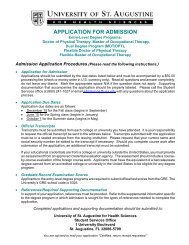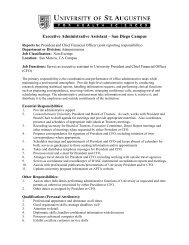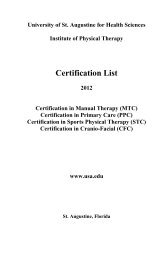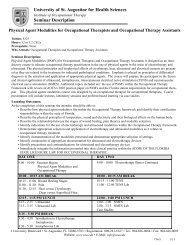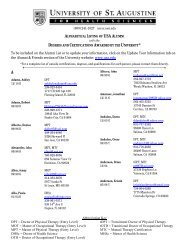CATALOG - University of St. Augustine for Health Sciences
CATALOG - University of St. Augustine for Health Sciences
CATALOG - University of St. Augustine for Health Sciences
Create successful ePaper yourself
Turn your PDF publications into a flip-book with our unique Google optimized e-Paper software.
established equivalency that reasonably approximates not less than (note that the DOE does notnecessarily think the word amount is quantifiable):1. One hour <strong>of</strong> classroom or direct faculty instruction (academic engagement) and a minimum <strong>of</strong>two hours <strong>of</strong> out <strong>of</strong> class preparation each week <strong>for</strong> approximately 15 weeks <strong>for</strong> one semester ortrimester <strong>of</strong> credit, or.. at least an equivalent amount <strong>of</strong> work over a different amount <strong>of</strong> time;2. Or at least an equivalent amount <strong>of</strong> work <strong>for</strong> other academic activities established by theinstitution including laboratory work, internships, practice, studio work, and other academic workleading to the award <strong>of</strong> credit hours.Example: one credit hour is 15 hours <strong>of</strong> academic engagement and 30 hours <strong>of</strong> preparation per a15 week term/trimester.Per the above, the <strong>University</strong> <strong>of</strong> <strong>St</strong>. <strong>Augustine</strong> further academic engagement to include direct orindirect faculty instruction. Academic engagement may include but is not limited to, submittingan academic assignment, listening to class lectures or webinars (synchronous or asynchronous),taking an exam, tutorials, computer-assisted instruction, <strong>for</strong>mal study groups, internships orlaboratory work. Preparation is typically homework, reading, study time, completingassignments and projects and papers and can include laboratory practice as well.All student work must be documented in the curriculum/syllabi, including a reasonableapproximation <strong>of</strong> time required <strong>for</strong> the student to complete the course work as well as gradingcriteria <strong>for</strong> determination <strong>of</strong> final grade <strong>for</strong> that course.Transfer CreditsTransfer <strong>of</strong> graduate credits previously earned from another accredited degree granting institution islimited to 15% <strong>of</strong> the total number <strong>of</strong> academic credits <strong>for</strong> the degree. Transfer <strong>of</strong> credits within the<strong>University</strong> is determined on a case by case basis. Transfer credit will in most cases be approved <strong>for</strong>graduate coursework awarded by schools, colleges or universities whose accrediting bodies haverecognition from the Council <strong>for</strong> Higher Education Accreditation (CHEA) or the US Department <strong>of</strong>Education.Acceptance or rejection <strong>of</strong> transfer credit is subject to the following provisions: The course(s) should have been completed within five (5) years preceding admission to the program;the applicant may petition the Program Director <strong>for</strong> an exception to this time limit. The course should have been completed with a grade <strong>of</strong> B or better. Courses having a B- or belowwill not be transferred. The course must be listed on an <strong>of</strong>ficial transcript sent directly to the Registrar by the issuinginstitution. The Program Director, in consultation with the appropriate course instructor(s), will review thetransfer course syllabus to verify that its contents match those <strong>of</strong> the program’s course. The ProgramDirector will then notify the Registrar <strong>of</strong> the decision. The course number and name <strong>of</strong> the course requested <strong>for</strong> transfer should reflect the content <strong>of</strong> thecourse it is replacing. Additionally, if the course requested <strong>for</strong> transfer will replace an elective, thecontent should be closely aligned with that <strong>of</strong> the curriculum and its potential electives. In cases where a course from a Master’s program is being requested <strong>for</strong> transfer into a doctoralprogram, consideration should be given to rigor and content and further documentation may berequested.The process <strong>for</strong> requesting transfer credits is as follows:29



